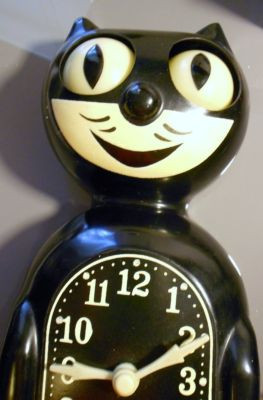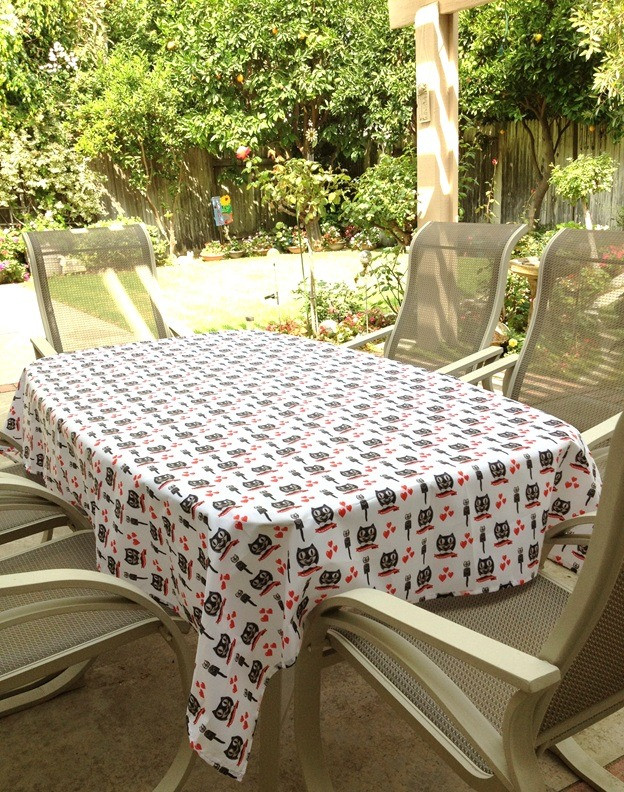The Felix The Cat Clock, often affectionately known as the Kit-Cat Clock, is more than just a timepiece; it’s a cultural icon that has been charming homes and captivating hearts for nearly a century. While not officially named after Felix the Cat, its animated eyes and wagging tail evoke a similar playful spirit, making it a beloved fixture in kitchens, nurseries, and beyond. This enduring appeal stems from its whimsical design, rich history, and continuous evolution, proving its ability to tick through time while maintaining its unique charm.
 Interim, still two-paw 1940’s design
Interim, still two-paw 1940’s design
From the Great Depression to Modern Homes: The Kit-Cat Clock Story
The story of the Felix the Cat Clock, or Kit-Cat Clock, begins in 1932, during the depths of the Great Depression. Earl Arnault, a designer from Portland, Oregon, envisioned a product that could bring a touch of cheer into homes during those challenging times. His creation was the Kit-Cat Clock, a novelty timepiece designed to uplift spirits with its perpetually moving eyes and pendulum tail. Initially sold in five-and-dime stores for around $3.95 (a significant $68 in today’s currency), the clock quickly gained popularity.
The original design of the Felix the Cat Clock featured a two-paw stance. This classic look remained until the 1950s when the design was updated to the four-paw version we are more familiar with today, complete with a bow tie for added dapper charm. The company behind these whimsical clocks, initially unnamed, navigated various changes, eventually becoming the California Clock Company after moving to California in 1962.
The Pin Connection: A Nod to Nostalgia
Like many enduring icons, the Felix the Cat Clock has spawned a range of related merchandise, including collectible pins. These pins serve as miniature tributes to the iconic clock, often featuring its recognizable silhouette and playful features. Acquiring a vintage pin of the Kit-Cat Clock is like holding a small piece of its history, a tangible connection to its long and fascinating journey.
One such pin, recently acquired, bears the inscription “Cathi & Boy’s Favorite Toys, Seattle, WA.” This detail, though seemingly minor, adds another layer to the clock’s story. While the California Clock Company moved to California in 1962, the presence of a Seattle retailer’s name on a pin suggests the widespread reach and popularity of the Felix the Cat Clock across different regions and eras, highlighting its appeal beyond geographical boundaries.
Surviving the Digital Age: Innovation and Adaptation
The Felix the Cat Clock faced a significant challenge as technology advanced and digital clocks began to dominate the market. The original clocks relied on electric motors to power not only the timekeeping mechanism but also the signature swiveling eyes and wagging tail. The shift towards battery-operated clocks presented a hurdle: batteries could power the clock function, but replicating the animated features proved complex.
This challenge was met head-on when Woody Young purchased the company in the 1980s. Faced with the problem of maintaining the clock’s iconic animation with battery power, Young ingeniously turned to an inventors’ conference. By recruiting individual inventors to tackle specific aspects of the problem, he successfully engineered a battery-operated prototype within a remarkable 30 days, ensuring the Felix the Cat Clock could continue to wiggle its tail and roll its eyes in the modern era.
 Pictorama pick for a clock today – sticking close to classic design
Pictorama pick for a clock today – sticking close to classic design
A Favorite of Celebrities and Collectors Alike
The Felix the Cat Clock‘s charm wasn’t limited to ordinary households. Legend has it that during the clock’s heyday in the 1940s, the iconic comedian Lucille Ball was such a fan that she would purchase them by the case as gifts. This celebrity endorsement further solidified the clock’s status as a desirable and whimsical item, adding to its cultural cachet.
Today, the Kit-Cat Klock website (kit-cat.com) showcases the vast evolution of the Felix the Cat Clock. From classic black and white models to versions adorned with eyelashes, gems, and pearl necklaces (“girl” cats), the variations are endless. The company also offers repair parts for vintage clocks dating back to the 1970s, demonstrating their commitment to the clock’s legacy and longevity, embodied in their slogan: “Bringing Time to Life Since 1932.”
Beyond Clocks: Embracing the Kit-Cat Brand
The enduring popularity of the Felix the Cat Clock has extended beyond timekeeping. The Kit-Cat Klock brand now encompasses a range of merchandise, from apparel like t-shirts and lapel pins to home goods such as tablecloths and even a monthly charm bracelet subscription. This expansion demonstrates the brand’s recognition and the desire of fans to incorporate the whimsical charm of the Felix the Cat Clock into other aspects of their lives.

A Personal Connection and Enduring Appeal
For many, including collectors and casual admirers, the Felix the Cat Clock holds a personal significance. Perhaps it was a fixture in their childhood home, a nostalgic reminder of simpler times. Or maybe it’s the clock’s inherent playfulness that brings a smile to their face. Whatever the reason, the Felix the Cat Clock continues to resonate with people across generations.
While some might find their animated eyes slightly unsettling (akin to a fear of clowns, as some suggest), the overwhelming sentiment is one of affection and nostalgia. The enduring appeal of the Felix the Cat Clock lies in its ability to blend functionality with whimsy, history with innovation, and a touch of vintage charm with timeless design. It’s more than just a clock; it’s a piece of Americana that continues to tick its way into our hearts and homes.
